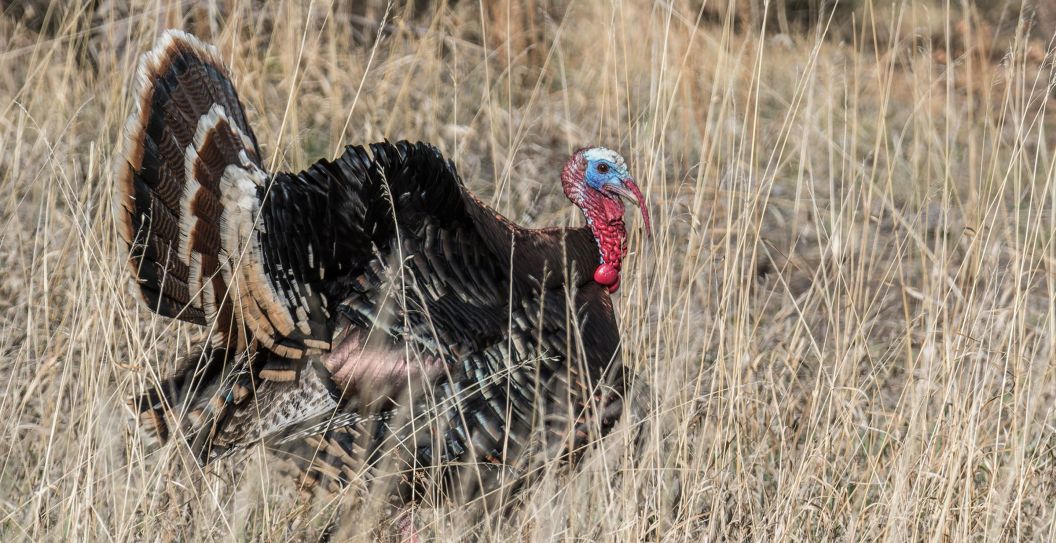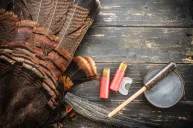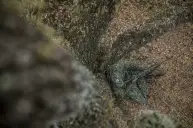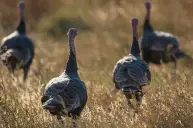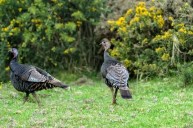In turkey hunting, the secret to success is to speak the turkey's language. It is being able to interpret the mood by listening to the birds' vocalizations and responding appropriately. It is a back-and-forth conversation. It is just as much about listening as it is about knowing how to call or respond.
The first step is to learn to decipher the sounds of the forest. Wild turkeys create some of the most unique sounds in nature, but they are easy to miss, especially for new turkey hunters. There are so many different sounds, including clucks, gobbles, and kee kees, plus the even more subtle sounds such as drumming, scratching in leaves, and purrs. There is so much to learn, and few types of hunting offer as many learning opportunities for sharpening communication skills as turkey hunting. Skilled turkey hunters know that filled tags usually come down to mastering the skill of communicating with gobblers.
Understanding Turkey Calls
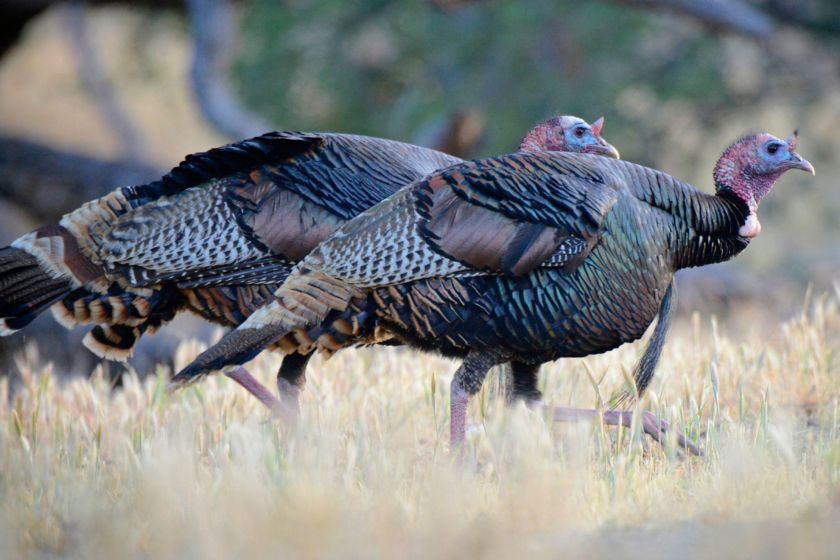
Getty, Lois_McCleary
Turkeys make a lot of different sounds, with each vocalization representing a different meaning. Animals communicate in a similar way to humans, using different note vocalizations to convey different messages.
Just like in life, in turkey hunting, miscommunication can throw off an entire social vibe. It would be like laughing during a funeral or sounding angry when praising a child. Those miscommunications would confuse the situation. The same goes for using the wrong call when turkey hunting.
Below are the most common sounds female turkeys (a.k.a. hens) and male turkeys (a.k.a. toms, jakes, or gobblers) make around the mating season. Using these different vocalizations in the turkey woods will help turkey hunters seal the deal.
Turkey Call #1: Yelp
The yelp is a basic turkey sound, heard from both male and female turkeys. The yelp sounds very similar to its name. It generally consists of shorter single notes normally strung together in a series of three to eight short notes strung together, kind of announcing a turkey's presence. It's basically the "Hey everyone, I'm over here!" call.
Like many turkey sounds, the yelp is implemented by turkeys in different scenarios, which makes it one of the most basic yet effective turkey calls to identify and learn. During the spring mating season, hens will use the yelp to locate and attract gobblers. The hen yelp is a good call to mimic what a hen does when she is on the lookout for a tom.
A tree yelp is often used by a roosted hen before she flies down, as a way to let other turkeys know she's awake and looking for the first tom that's ready for action. A call like this is almost nearly just a softer, plain yelp, but can be key for a hunter to getting a gobbler off the roost to draw him in to your setup before he has a chance to move to another hen.
Turkey Call #2: Cluck
The cluck is a call used by all adult birds, both gobblers and hens. When a gobbler is making a plain cluck, it's usually an indication that "Hey, I'm just here." It will come in a slower cadence often times with other turkey sounds like a yelp, or just by itself.
When a hen uses single note clucks, it holds a similar meaning as a tom and is usually in conjunction with feeding or just moving around the area. Often times, soft clucking can be confused with a putt (next on this list)—it's not a loud call and sometimes hard to distinguish—and understanding the difference can mean a tagged turkey or coming home empty-handed.
The cluck is a good call to mimic when you need to finesse a gobbler that's showing some hesitation.
Turkey Call #3: Putt
A putt can sound similar to a cluck but has a totally different meaning. The putt sound is normally associated with an alarm or danger. The sound is a short and sharp note, commonly strung together in a slow series. Often you'll hear it in a fading sequence because it's usually when a turkey is running away from you telling their flock mates, "Everyone run! Get out of here, something dangerous is near!"
If you hear a turkey make a putt sound, you've probably been found out. Ever hear a deer blow at you in the woods? This is a very similar concept. If you take your lips and press them together and say "putt, putt, putt" you have nearly mastered the call. However, this is rarely a sound you're going to want to make yourself, as in most situations it's going to tell the bird it's time to run.
Turkey Call #4: Cutt
The cutt sound is a series of loud and fast clucks mixed in with some yelps. It's used by hens when they're fired up. If a gobbler has gone silent, many times this call will work to get a response.
My father used to describe cutting to me as a truck trying to start with a plugged fuel line. As the engine turns over, it cuts in and out in a "ba-boom, ba-boom, boom, boom, ba-boom." Be careful to know the difference between cutting and putting because, again, while these two turkey sounds are very similar, they do have two totally different meanings.
If you use the cutt sound, try not to overdo it, as sometimes a silent tom may just be around the corner, and cutting may just be too much for him, depending on the scenario.
Turkey Call #5: Purr
I like to think of the purr as someone humming a song or whistling as they go about their business. Usually, it means the bird has a feeling of contentment. You'll mostly hear it from feeding birds who want to maintain contact with one another, or from maybe from a hen communicating with her grown poults.
If you hunt enough or watch enough turkey hunts, you may also hear a tom purr as a sign of aggression. This can occur while one gobbler is invading another gobbler's area or as one moves in to try to force out another gobbler.
If you have a good enough setup, you may be lucky enough to catch a gobbler purring his way in to attack your jake or tom decoy, which adds some excitement to the hunt.
Turkey Call #6: Cackle
Often called the "fly-down cackle," this call is usually heard as a turkey leaves the roost and flies down to the ground. Most turkeys will start with a tree yelp indicating their location. Then, when they're ready to leave the roost, they cackle. A cackle starts as quick clucks and cuts, and as the bird lands, the cadence slows down, often moving into yelps.
The cackle sound is often accompanied with the loud sound of flapping wings. If you're in the woods and hear the cackle, it's a good sign that you got up early enough for the morning hunt. And, naturally, you're going to have the most luck using a cackle call during those same early hours.
Turkey Call #7: Kee-kee and Kee-kee-run
This was my favorite call when I was 12 years old and a Jake member with the National Wild Turkey Federation (NWTF) entering into turkey calling competitions. Now granted, I never won a competition, but I'll always remember being up on stage and holding true to my grandmother's nickname for me,"Little Turkey."
The kee-kee-run is pretty much just that: a little turkey. Hunters often use this in the fall when a flock of turkeys has separated, and a young turkey, or poult, is trying to yelp back to its mother. It's an indication that the young bird is lost and wants to be found.
The sound is a series of attempted yelps. High-pitched "pee-pee-pee-pee-pee" sounds is the only way I can think to describe it. As a turkey gets an actual yelp out, the call becomes known as the kee-kee-run, starting with the high-pitched sound and ending with a quick series of loud yelps that sounds something like "pee-pee-pee-pee-yelp-yelp."
A good hunting strategy for the fall hunting season is to scare off and separate a flock of turkeys, set up, and use the kee-kee-run to imitate a lost bird as an attempt to pull in the more mature hens and toms.
Turkey Call #8: Gobble
We saved the best turkey call for last. Of all the turkey calls you may hear in the woods, this vocalization is the one you want to hear. The gobble is the king daddy of turkey calls, one of the principal vocalizations of the male turkey. This sound is an indication that a tom or jake is excited and wants a hen. It's used to attract hens but also to deter other toms and jakes.
Jakes sometimes can fool you into thinking they're a tom when they gobble, however sometimes they'll yelp in response to your calling until they actually can gobble. If you haven't heard a turkey gobble in the woods yet, prepare to hear a sound that recruits and retains more and more turkey hunters every year.
Turkey Call Tips and Tricks
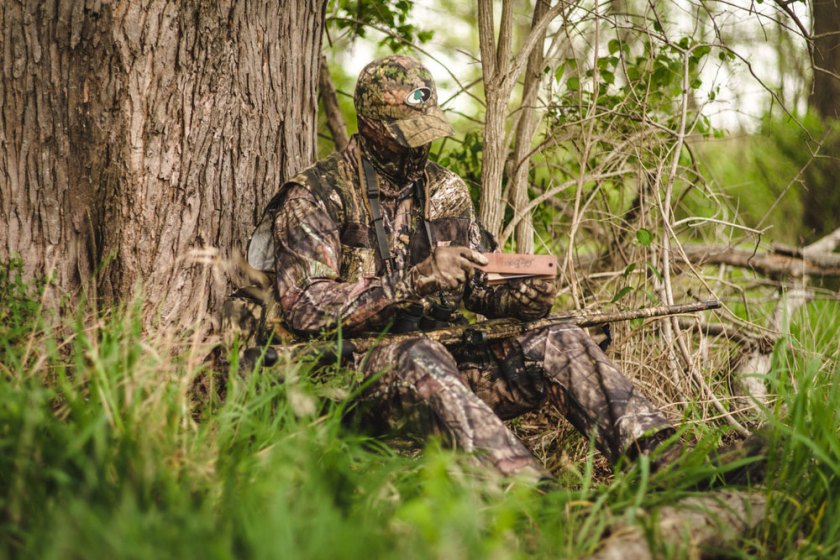
Mossy Oak
No matter if you're calling, hunting, or both, understanding the sounds turkeys make is vital in having a successful hunt, especially on public land where there might be other turkey hunters nearby.
Take the time to listen to the sounds, distinguish their differences, and understand what each sound means. When in doubt, less is more when mimicking the calls. You can't scare a turkey away by calling too little. One of the biggest mistakes turkey hunters make is getting too overzealous with their call and tipping that big gobbler off. Think like a hen and play hard to get.
